When to start baby sign language: A friendly guide
Read this article to learn when to start baby sign language to help your baby express herself/himself, boost early communication, and reduce frustration.
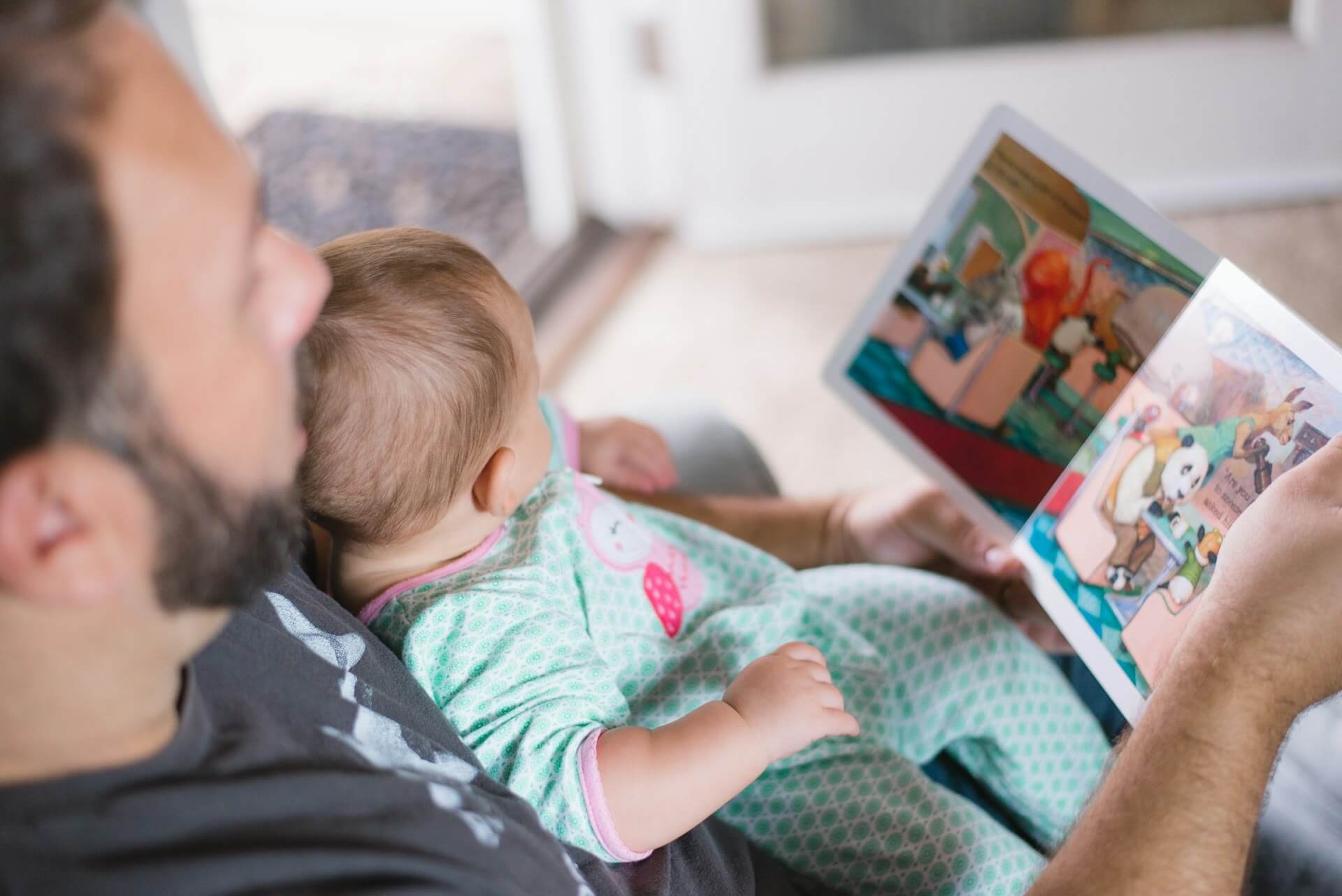
The best time to begin teaching sign language to your little one is when they are around 6 months old. At this age, babies are developing the necessary motor skills and are naturally curious. This makes it the perfect time to introduce this form of communication. You can start earlier, around 4 to 6 months, but expect the baby to take a little while to sign back. Babies typically begin using their first signs when they are between 8 and 10 months old. It's about consistency and patience.
Before a baby can speak, they can communicate through signs.
Baby sign language offers a helpful way for infants to express their needs and emotions.
One of the most common questions parents have is when they should begin teaching their baby to sign.
The best time to start teaching your baby signs is around 6 months. At this age, babies have the attention span to begin noticing your hand signs.
But that doesn't mean they will start signing back immediately. They will develop this ability when they are eight to 10 months old.
If you want to know more about when to start baby sign language, keep reading.
When to start teaching sign language to your baby?
You can start teaching your baby sign language when they are 4 to 6 months old.
At this age, babies begin to notice gestures and connect them with meaning.
Their motor skills are still developing. So, they may not sign back right away. However, starting early builds a strong foundation.
Most babies begin signing back when they are around 8 to 10 months old. At this time, they have better hand control and understand more about their world.
Experts recommend starting sign language around 6 months. This includes the American Academy of Pediatrics.
This is when babies begin to sit up, engage with you more, and show signs of understanding routines.
You don't need to wait for your baby to sign first. Repetition and consistency are key.
Many parents start with daily signs like "milk," "more," and "all done."
These relate to your baby's most common needs. Signing during meals, diaper changes, and playtime helps your baby connect gestures with real actions.
Even if your baby doesn't sign back right away, they are watching and learning.
Over time, you'll see your baby use their hands to communicate. This reduces frustration and builds strong communication.
What about deaf babies?
For Deaf babies, sign language should be introduced as early as possible. Ideally, this means from birth.
Here's why:
- Language access from day one
Deaf babies, like all babies, need full access to language. That's how they develop communication skills, thinking abilities, and emotional connections. They may not have full access to spoken language. But sign language provides clear, visual communication that they can perceive naturally. Early exposure ensures their brain develops language pathways at the same pace as hearing babies exposed to speech.
- No need to wait for milestones
For hearing babies, signs often supplement spoken language. Deaf babies use sign language as their primary or full language. There's no need to wait for speech development. They are already fully ready to receive language visually.
- Supports cognitive and social development
Deaf babies exposed to sign language from birth develop language skills on par with, or even ahead of, hearing babies. They also tend to have better social-emotional development. That's because they can express needs and emotions clearly from an early age.
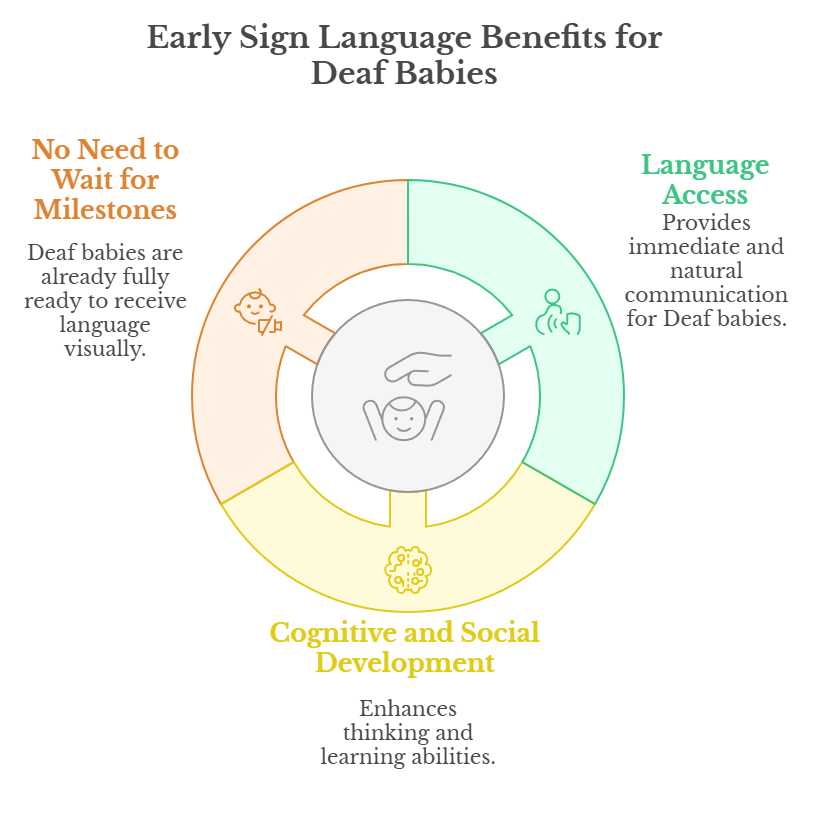
Start signing with Deaf babies from birth, just like you would speak to a hearing newborn. Use signs during feeding, cuddling, play, and routines.
Deaf children need and deserve early, rich language exposure to thrive.
Why is it important to introduce sign language so early?
Introducing sign language early can make a big difference in their development. This applies to Deaf and hearing babies.
Babies begin learning language long before they can talk. Giving them access to signs gives them a way to connect, understand, and be understood.
This is why early sign language matters for all babies:
- It boosts brain development.
- It supports early language skills.
- It strengthens bonding with caregivers.
- It reduces frustration and tantrums.
- It helps babies express their needs before they can talk.
- It improves understanding of routines and choices.
- It may lead to stronger spoken vocabulary later on.
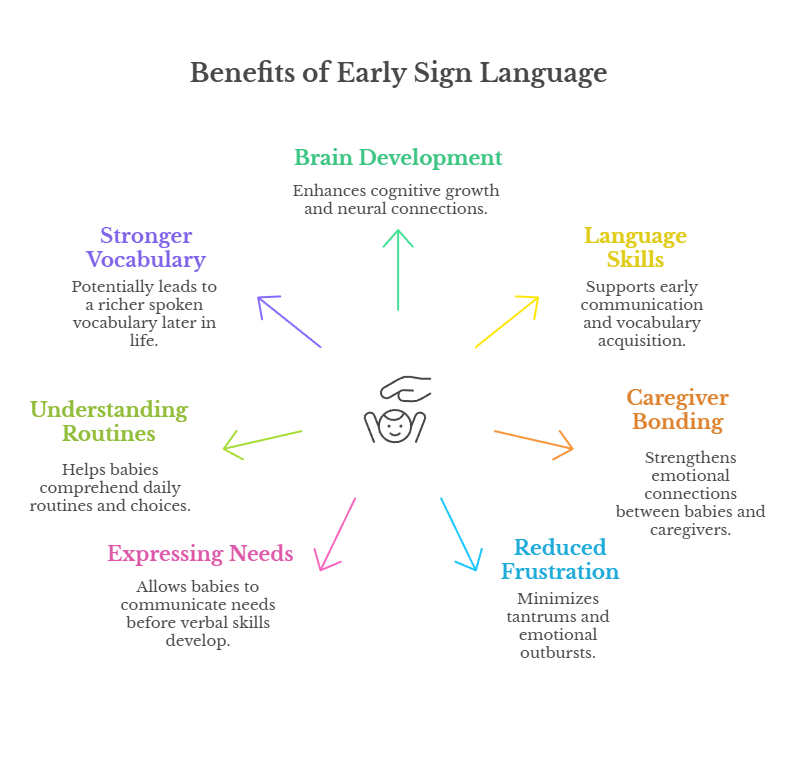
Teaching babies signs early helps them feel seen, heard, and understood. It's a simple tool with powerful results for every baby.
For Deaf babies
Sign language is the most natural and effective way for Deaf babies to learn and use language.
Since they may not hear spoken words, they rely on their eyes to take in information.
Sign language gives them full access to communication in a way that makes sense to them.
It's important to start from birth. Just like hearing babies are surrounded by speech, Deaf babies should be surrounded by signs.
Their brains are built to learn language in the early months of life. Sign language gives them the tools they need to grow and connect.
When Deaf babies are exposed to signs early, they build strong language skills. They also develop social awareness and emotional security.
They can express their needs, share feelings, and bond with family without having to cry or guess.
Families who sign with their Deaf babies also feel more connected since they can understand each other more easily.
For hearing babies
Hearing babies usually don't start speaking their first real words until they are 10 to 18 months old.
But long before they can talk, they're already trying to communicate. They babble, gesture, point, and cry, all signs that their brains are ready for language.
That's where sign language comes in.
Signing gives hearing babies a way to share their thoughts before their mouths can form the words.
When babies learn to sign for "milk" or "all done," they can express what they want without tears or guessing games.
This makes daily life smoother and helps babies feel understood.
Using signs doesn't slow down speech. It can actually help it grow.
Hearing babies who sign often speak earlier, learn words faster, and show strong language skills in preschool.
Signing also builds confidence. Babies who can sign often feel proud and eager to keep learning.
It's a simple way to boost learning and deepen your connection with your child, right from the start.
How to introduce sign language to your baby
Teaching your baby sign language doesn't have to be complicated.
The key is to start small, be consistent, and make it part of your everyday life. You don't need to set aside special time, just sign during the moments you already share.
Choosing your first signs
Start with signs that are simple, useful, and tied to your baby's daily needs.
These signs should come up often during your routines so your baby can see them used many times each day.
Here are good signs to start with:
- Milk – For nursing or bottle-feeding
- Eat or Food – When offering snacks or meals
- More – For asking for more of something (food, play, etc.)
- All Done – To end a meal or activity
- Mom and Dad – For the people they see every day
- Sleep – At nap time or bedtime
- Water – When giving a drink
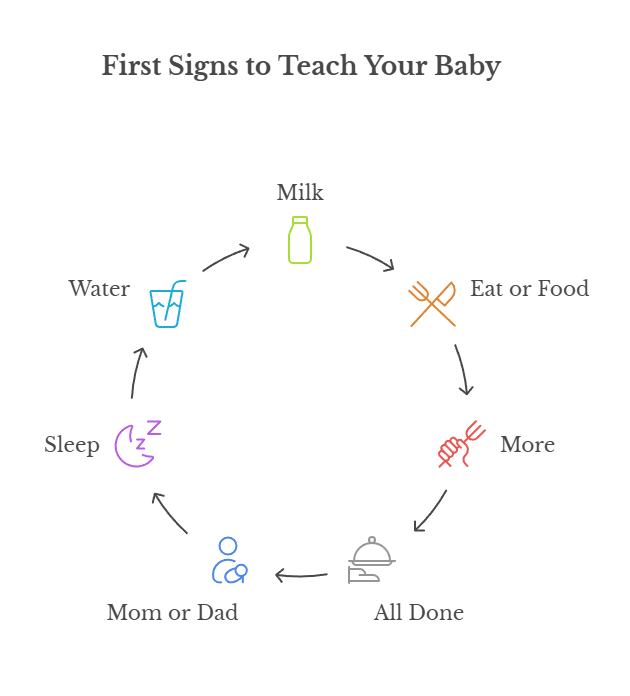
Pick three to five signs to begin with and use them often.
As your baby learns, you can add more based on their interests (like animals, toys, or emotions).
Creating a routine for signing
Make signing a natural part of your day. You don't need a lesson plan, just add signs to things you already do.
The more your baby sees the signs, the faster they'll learn.
Here are ways to build signs into your routine:
- Always sign and say the word together
- Use the same signs at the same times each day
- Sign during feeding times (milk, eat, more, all done)
- Use signs during playtime (more, help, ball, up)
- Add signs to bedtime or bath routines (sleep, water, all done)
- Have everyone in the family use the same signs
- Celebrate your baby's attempts, even if they're not perfect
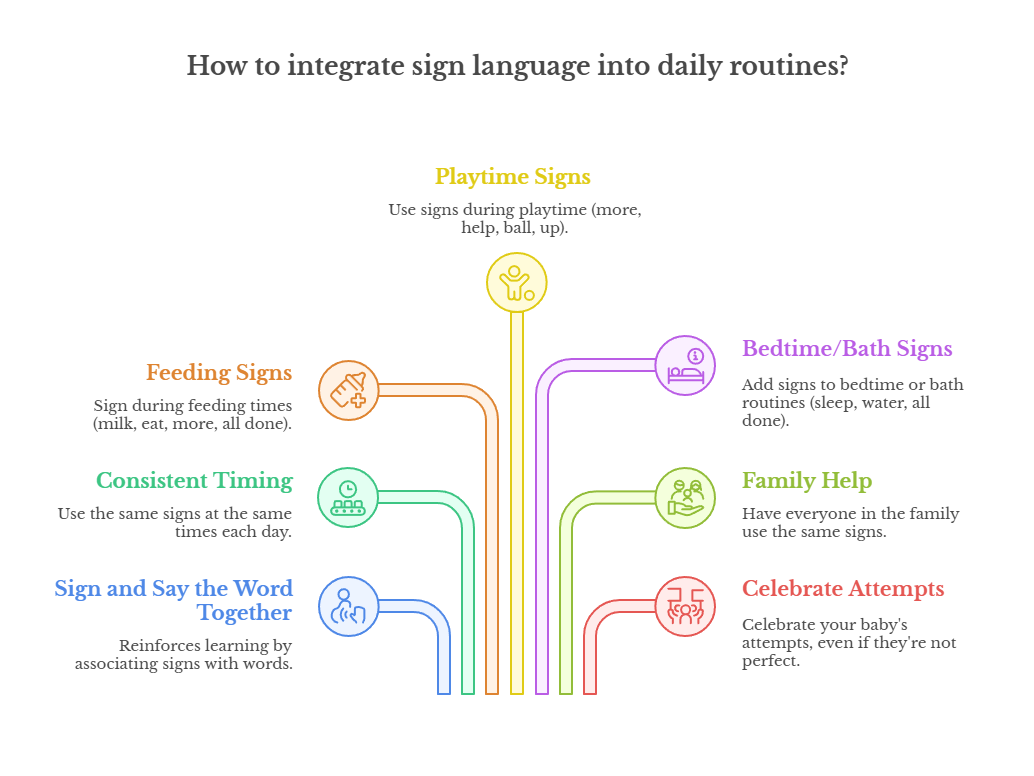
Consistency and repetition are the most important parts. Keep signing every day, even if your baby doesn't respond right away.
Over time, they'll surprise you by signing back, and you'll both enjoy the new way to communicate.
Start baby sign language when the time is right
Introducing sign language early gives your baby a powerful tool to connect with you before they can speak.
You can teach your baby to sign even if they're Deaf, Hard of Hearing, or hearing.
Doing so will support brain growth, reduce frustration, and build strong emotional bonds.
Your baby may not sign back right away. But, with patience and consistency, they will start to sign back when they're ready.
Every baby deserves full access to language. With sign language, you're giving them a head start not just in talking, but in thinking, feeling, and growing.
Want help getting started?
Try the ASL Bloom app to learn easy, baby-friendly signs and build confidence as you go. We have a collection made especially for teaching babies signs.
It's free to download and made for parents just like you.
Start Learning ASL Today
Start your ASL learning journey today! Download the ASL Bloom app and take the first step toward learning American Sign Language.
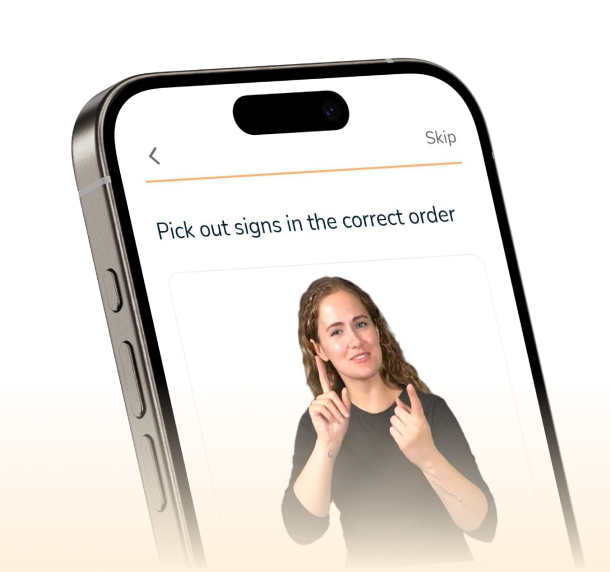
Start Learning ASL Today
Start your ASL learning journey today! Download the ASL Bloom app and take the first step toward learning American Sign Language.
.webp)


.png)